- Home
- Neal Stephenson
Some Remarks: Essays and Other Writing Page 13
Some Remarks: Essays and Other Writing Read online
Page 13
Today, another 120 years later, we take wires completely for granted. This is most unwise. People who use the Internet (or for that matter, who make long-distance phone calls) but who don’t know about wires are just like the millions of complacent motorists who pump gasoline into their cars without ever considering where it came from or how it found its way to the corner gas station. That works only until the political situation in the Middle East gets all screwed up, or an oil tanker runs aground on a wildlife refuge. In the same way, it behooves wired people to know a few things about wires—how they work, where they lie, who owns them, and what sorts of business deals and political machinations bring them into being.
In the hopes of learning more about the modern business of really, really long wires, we spent much of the summer of 1996 in pursuits such as: being arrested by toothless, shotgun-toting Egyptian cops; getting pushed around by a drunken smuggler queen on a Thai train; vaulting over rustic gates to take emergency shits in isolated fields; being kept awake by groovy Eurotrash backpackers singing songs; blowing Saharan dust out of cameras; scraping equatorial mold out of fountain pens; stuffing faded banknotes into the palms of Egyptian service-industry professionals; trying to persuade non-English-speaking taxi drivers that we really did want to visit the beach even though it was pouring rain; and laundering clothes by showering in them. We still missed more than half the countries FLAG touches.
Our method was not exactly journalism nor tourism in the normal sense but what might be thought of as a new field of human endeavor called hacker tourism: travel to exotic locations in search of sights and sensations that only would be of interest to a geek.
I will introduce sections with readings from my trusty GPS in case other hacker tourists would like to leap over the same rustic gates or get rained on at the same beaches.
5˚ 26.325' N, 100˚ 17.417' E Penang Botanical Gardens
Penang, one of the first sites visited by this hacker tourist partly because of its little-known historical importance to wires, lies just off the west coast of the Malay Peninsula. The British acquired it from the local sultan in the late 1700s, built a pathetic fort above the harbor, and named it, appropriately, after the hapless General Cornwallis. They set up a couple of churches and established the kernel of a judicial system. A vigorous market grew up around them. A few kilometers away, they built a botanical garden.
This seems like an odd set of priorities to us today. But gardens were not mere decorations to the British—they were strategic installations.
The headquarters was Kew Gardens outside of London. Penang was one of the forward outposts, and it became incomparably more important than the nearby fort. In 1876, 70,000 seeds of the rubber tree, painstakingly collected by botanists in the Amazon rain forest, were brought to Kew Gardens and planted in a greenhouse. About 2,800 of them germinated and were shipped to the botanical gardens in Sri Lanka and Penang, where they propagated explosively and were used to establish rubber plantations.
Most of these plantations were on the neighboring Malay Peninsula, a lumpy, bony tentacle of land that stretches for 1,000 miles from Bangkok in the north to Singapore in the south, where it grazes the equator. The landscape is a stalemate between, on one hand, the devastatingly powerful erosive forces of continual tropical rainstorms and dense plant life, and, on the other hand, some really, really hard rocks. Anything with the least propensity to be eroded did so a long time ago and turned into a paddy. What’s left are ridges of stone that rise almost vertically from the landscape and are still mostly covered with rain forest, notwithstanding efforts by the locals to cut it all down. The flat stuff is all used for something—coconuts, date palms, banana trees, and above all, rubber.
Until artificial rubber was invented by the colony-impaired Germans, no modern economy could exist without the natural stuff. All of the important powers had tropical colonies where rubber was produced. For the Netherlands, it was Indonesia; for France, it was Indochina; for the British, it was what they then called Malaya, as well as many other places.
Without rubber and another kind of tree resin called gutta-percha, it would not have been possible to wire the world. Early telegraph lines were just naked conductors strung from pole to pole, but this worked poorly, especially in wet conditions, so some kind of flexible but durable insulation was needed. After much trial and error, rubber became the standard for terrestrial and aerial wires while gutta-percha (a natural gum also derived from a tree grown in Malaya) was used for submarine cables. Gutta-percha is humble-looking stuff, a nondescript brown crud that surrounds the inner core of old submarine cables to a thickness of perhaps 1 centimeter, but it was a wonder material back in those days, and the longer it remained immersed in salt water, the better it got.
So far, it was all according to the general plan that the British had in mind: find some useful DNA in the Americas, stockpile it at Kew Gardens, propagate it to other botanical gardens around the world, make money off the proceeds, and grow the economy. Modern-day Penang, however, is a good example of the notion of unintended consequences.
As soon as the British had established the rule of law in Penang, various kinds of Chinese people began to move in and establish businesses. Most of them were Hokkien Chinese from north of Hong Kong, though Cantonese, Hakka, and other groups also settled there. Likewise, Tamils and Sikhs came from across the Bay of Bengal. As rubber trees began to take over the countryside, a common arrangement was for Chinese immigrants to establish rubber plantations and hire Indian immigrants (as well as Malays) as laborers.
The British involvement, then, was more catalytic than anything else. They didn’t own the rubber plantations. They merely bought the rubber on an open market from Chinese brokers who in turn bought it from producers of various ethnicities. The market was just a few square blocks of George Town where British law was enforced, i.e. where businessmen could rely on a few basics like property rights, contracts, and a currency.
During and after World War II, the British lost what presence they had here. Penang fell to the Japanese and became a base for German U-Boats patrolling the Indian Ocean. Later, there was a somewhat messy transition to independence involving a communist insurrection and a war with Indonesia. Today, Malaysia is one of Asia’s economic supernovas and evidently has decided that it will be second to none when it comes to the Internet. They are furiously wiring up the place and have established JARING, which is the Malaysian Internet (this word is a somewhat tortured English acronym that happens to spell out the Malay word for the Net).
If you have a look at JARING’s homepage (www.jaring.my/jaring), you will be confronted by a link that will take you to a page reciting Malaysia’s censorship laws, which, like most censorship laws, are ridiculously vague and hence sort of creepy and yet, in the context of the Internet, totally unworkable.
In a way, the architects of JARING are trying to run the Kew Gardens experiment all over again. By adopting the Internet protocol for their national information infrastructure, they have copied the same DNA that, planted in the deregulated telecom environment of the United States, has grown like some unstoppable exotic weed. Now they are trying to raise the same plant inside a hothouse (because they want it to flourish) but in a pot (because they don’t want it to escape into the wild).
They seem to have misunderstood both their own history and that of the Internet, which run strangely parallel. Today the streets of George Town, Penang’s main city, are so vivid, crowded, and intensely multicultural that by comparison they make New York City look like Colonial Williamsburg. Every block has a mosque or Hindu temple or Buddhist shrine or Christian church. You can get any kind of food, hear any language. The place is thronged, but it’s affluent, and it works. It’s a lot like the Internet.
Both Penang and the Internet were established basically for strategic military reasons. In both cases, what was built by the military was merely a kernel for a much vaster phenomenon that came along later. This kernel was really nothing more than a protocol, a s
et of rules. If you wanted to follow those rules, you could participate, otherwise you were free to go elsewhere. Because the protocol laid down a standard way for people to interact, which was clearly set out and could be understood by anyone, it attracted smart, adaptable, ambitious people from all over the place, and at a certain point it flew completely out of control and turned into something that no one had ever envisioned: something thriving, colorful, wildly diverse, essentially peaceful, and plagued only by the congestion of its own success.
JARING’s link to the global Internet is over an undersea cable that connects it to the United States. This is typical of many Southeast Asian countries, which are far better connected to the US than they are to one another. But in late June of 1996, a barge called the Elbe appeared off the coast of Penang. Divers and boats came ashore, braving an infestation of sea snakes, and floated in a segment of armored cable that will become Malaysia’s link to FLAG. The capacity of that cable is theoretically some 5.3 Gbps. Much of this will be used for telephone and other non-Internet purposes, but it can’t help but serve as a major floodgate between JARING, the censored pseudo-Internet of Malaysia, and the rest of the Net. After that, it will be interesting to see how long JARING remains confined to its pot.
FLAG FACTS
The FLAG system, that mother of all wires, starts at Porthcurno, England, and proceeds to Estepona, Spain; through the Strait of Gibraltar to Palermo, Sicily; across the Mediterranean to Alexandria and Port Said, Egypt; overland from those two cities to Suez, Egypt; down the Gulf of Suez and the Red Sea, with a potential branching unit to Jedda, Saudia Arabia; around the Arabian Peninsula to Dubai, site of the FLAG Network Operations Center; across the Indian Ocean to Bombay; around the tip of India and across the Bay of Bengal and the Andaman Sea to Ban Pak Bara, Thailand, with a branch down to Penang, Malaysia; overland across Thailand to Songkhla; up through the South China Sea to Lan Tao Island in Hong Kong; up the coast of China to a branch in the East China Sea where one fork goes to Shanghai and the other to Koje-do Island in Korea, and finally to two separate landings in Japan—Ninomiya and Miura, which are owned by rival carriers.
Phone company people tend to think (and do business) in terms of circuits. Hacker tourists, by contrast, tend to think in terms of bits per second. Converting between these two units of measurements is simple: on any modern phone system, the conversations are transmitted digitally, and the standard bit rate that is used for this purpose is 64 kbps. A circuit, then, in telephony jargon, amounts to a datastream of 64 kbps.
Copper submarine cables of only a few decades ago could carry only a few dozen circuits—say, about 2,500 kbps total. The first generation of optical-fiber cables, by contrast, carries more than 1,000 times as much data—280 Mbps of data per fiber pair. (Fibers always come in pairs. This practice seems obvious to a telephony person, who is in the business of setting up symmetrical two-way circuits, but makes no particular sense to a hacker tourist who tends to think in terms of one-way packet transmission. The split between these two ways of thinking runs very deep and accounts for much tumult in the telecom world, as will be explained later.) The second generation of optical-fiber cables carries 560 Mbps per fiber pair. FLAG and other third-generation systems will carry 5.3 Gbps per pair. Or, in the system of units typically used by phone company people, they will carry 60,000 circuits on each fiber pair.
If you multiply 60,000 circuits times 64 kbps per circuit, you get a bit rate of only 3.84 Gbps, which leaves 1.46 Gbps unaccounted for. This bandwidth is devoted to various kinds of overhead, such as frame headers and error correction. The FLAG cable contains two sets of fiber pairs, and so its theoretical maximum capacity is 120,000 circuits, or (not counting the overhead) just under 8 Gbps of actual throughput.
These numbers really knock ’em dead in the phone industry. To the hacker tourist, or anyone who spends much time messing around with computer networks, they seem distinctly underwhelming. All this trouble and expense for a measly 8 Gbps? You’ve got to be kidding! Again, it comes down to a radical difference in perspective between telephony people and Internet people.
In defense of telephony people, it must be pointed out that they are the ones who really know the score when it comes to sending bits across oceans. Netheads have heard so much puffery about the robust nature of the Internet and its amazing ability to route around obstacles that they frequently have a grossly inflated conception of how many routes packets can take between continents and how much bandwidth those routes can carry. As of this writing, I have learned that nearly the entire state of Minnesota was recently cut off from the Internet for 13 hours because it had only one primary connection to the global Net, and that link went down. If Minnesota, of all places, is so vulnerable, one can imagine how tenuous many international links must be.
Douglas Barnes, an Oakland-based hacker and cypherpunk, looked into this issue a couple of years ago when, inspired by Bruce Sterling’s Islands in the Net, he was doing background research on a project to set up a data haven in the Caribbean. “I found out that the idea of the Internet as a highly distributed, redundant global communications system is a myth,” he discovered. “Virtually all communications between countries take place through a very small number of bottlenecks, and the available bandwidth simply isn’t that great.” And he cautions: “Even outfits like FLAG don’t really grok the Internet. The undersized cables they are running reflect their myopic outlook.”
So the bad news is that the capacity of modern undersea cables like FLAG isn’t very impressive by Internet standards, but the slightly better news is that such cables are much better than what we have now. Here’s how they work: Signals are transmitted down the fiber as modulated laser light with a wavelength of 1,558 nanometers (nm), which is in the infrared range. These signals begin to fade after they have traveled a certain distance, so it’s necessary to build amplifiers into the cable every so often. In the case of FLAG, the spacing of these amplifiers ranges from 45 to 85 kilometers. They work on a strikingly simple and elegant principle. Each amplifier contains an approximately 10-meter-long piece of special fiber that has been doped with erbium ions, making it capable of functioning as a laser medium. A separate semiconductor laser built into the amplifier generates powerful light at 1,480 nm—close to the same frequency as the signal beam, but not close enough to interfere with it. This light, directed into the doped fiber, pumps the electrons orbiting around those erbium ions up to a higher energy level.
The signal coming down the FLAG cable passes through the doped fiber and causes it to lase, i.e., the excited electrons drop back down to a lower energy level, emitting light that is coherent with the incoming signal—which is to say that it is an exact copy of the incoming signal, except more powerful.
The amplifiers need power—up to 10,000 volts DC, at 0.9 amperes. Since public 10,000-volt outlets are few and far between on the bottom of the ocean, this power must be delivered down the same cable that carries the fibers. The cable, therefore, consists of an inner core of four optical fibers, coated with plastic jackets of different colors so that the people at opposite ends can tell which is which, plus a thin copper wire that is used for test purposes. The total thickness of these elements taken together is comparable to a pencil lead; they are contained within a transparent plastic tube. Surrounding this tube is a sheath consisting of three steel segments designed so that they interlock and form a circular jacket. Around that is a layer of about 20 steel “strength wires”—each perhaps 2 mm in diameter—that wrap around the core in a steep helix. Around the strength wires goes a copper tube that serves as the conductor for the 10,000-volt power feed. Only one conductor is needed because the ocean serves as the ground wire. This tube also is watertight and so performs the additional function of protecting the cable’s innards. It then is surrounded by polyethylene insulation to a total thickness of about an inch. To protect it from the rigors of shipment and laying, the entire cable is clothed in good old-fashioned tarred jute, although jute nowadays is made fro
m plastic, not hemp.
This suffices for the deep-sea portions of the cable. In shallower waters, additional layers of protection are laid on, beginning with a steel antishark jacket. As the shore is approached, various other layers of steel armoring wires are added.
This more or less describes how all submarine cables are being made as of 1996. Only a few companies in the world know how to make cables like this: AT&T Submarine Systems International (AT&T-SSI) in the US, Alcatel in France, and KDD Submarine Cable Systems (KDD-SCS) in Japan, among others. AT&T-SSI and KDD-SCS frequently work together on large projects and are responsible for FLAG. Alcatel, in classic French fasion, likes to go it alone.
This basic technology will, by the end of the century, be carrying most of the information between continents. Copper-based coaxial cable systems are still in operation in many places around the world, but all of them will have reached the end of their practical lifetimes within a few years. Even if they still function, they are not worth the trouble it takes to operate them. TPC–1 (Trans Pacific Cable #1), which connected Japan to Guam and hence to the United States in 1964, is still in perfect working order, but so commercially worthless that it has been turned over to a team at Tokyo University, which is using it to carry out seismic research. The capacity of such cables is so tiny that modern fiber cables could absorb all of their traffic with barely a hiccup if the right switches and routers were in place. Likewise, satellites have failed to match some of the latest leaps in fiber capacity and can no longer compete with submarine cables, at least until such time as low-flying constellations such as Iridium and Teledesic begin operating.
Within the next few years, several huge third-generational optical fiber systems will be coming online: not only FLAG but a FLAG competitor called SEA-ME-WE 3 (Southeast Asia-Middle East-Western Europe #3); TPC–5 (Trans-Pacific Cable #5); APCN (Asia-Pacific Cable Network), which is a web of cables interconnecting Japan, Korea, Hong Kong, Taiwan, Malaysia, Thailand, Indonesia, Singapore, Australia, and the Philippines; and the latest TAT (Transatlantic) cable. So FLAG is part of a trend that will soon bring about a vast increase in intercontinental bandwidth.

 Zodiac: The Eco-Thriller
Zodiac: The Eco-Thriller The Mongoliad: Book One
The Mongoliad: Book One Snow Crash
Snow Crash The Confusion: Volume Two of the Baroque Cycle
The Confusion: Volume Two of the Baroque Cycle The Rise and Fall of D.O.D.O.
The Rise and Fall of D.O.D.O. The Diamond Age: Or, a Young Lady's Illustrated Primer
The Diamond Age: Or, a Young Lady's Illustrated Primer The Big U
The Big U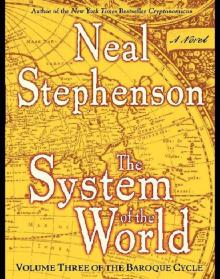 The System of the World: Volume Three of the Baroque Cycle
The System of the World: Volume Three of the Baroque Cycle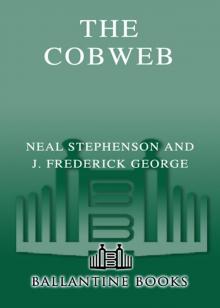 The Cobweb
The Cobweb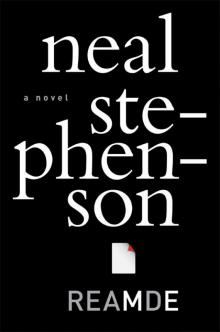 Reamde
Reamde Fall; or, Dodge in Hell
Fall; or, Dodge in Hell Interface
Interface Quicksilver
Quicksilver The Mongoliad: Book Three
The Mongoliad: Book Three Seveneves
Seveneves Atmosphæra Incognita
Atmosphæra Incognita In the Beginning...Was the Command Line
In the Beginning...Was the Command Line Anathem
Anathem The Rise and Fall of D.O.D.O.: A Novel
The Rise and Fall of D.O.D.O.: A Novel The Mongoliad: Book Two
The Mongoliad: Book Two Diamond Age or a Young Lady's Illustrated Primer
Diamond Age or a Young Lady's Illustrated Primer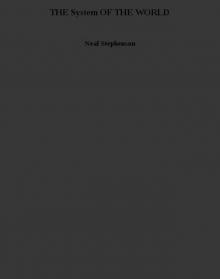 THE System OF THE WORLD
THE System OF THE WORLD The Mongoliad: Book One tfs-1
The Mongoliad: Book One tfs-1 Some Remarks: Essays and Other Writing
Some Remarks: Essays and Other Writing Zodiac
Zodiac Spew
Spew The Baroque Cycle: Quicksilver, the Confusion, and the System of the World
The Baroque Cycle: Quicksilver, the Confusion, and the System of the World The Diamond Age
The Diamond Age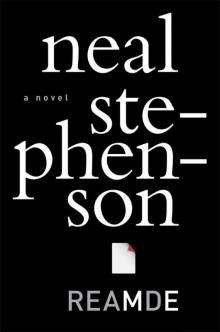 Reamde: A Novel
Reamde: A Novel In the Kingdom of Mao Bell
In the Kingdom of Mao Bell Mother Earth Mother Board
Mother Earth Mother Board Twelve Tomorrows - Visionary stories of the near future inspired by today's technologies
Twelve Tomorrows - Visionary stories of the near future inspired by today's technologies The Confusion
The Confusion The Great Simoleon Caper
The Great Simoleon Caper The Mongoliad: Book Three tfs-3
The Mongoliad: Book Three tfs-3